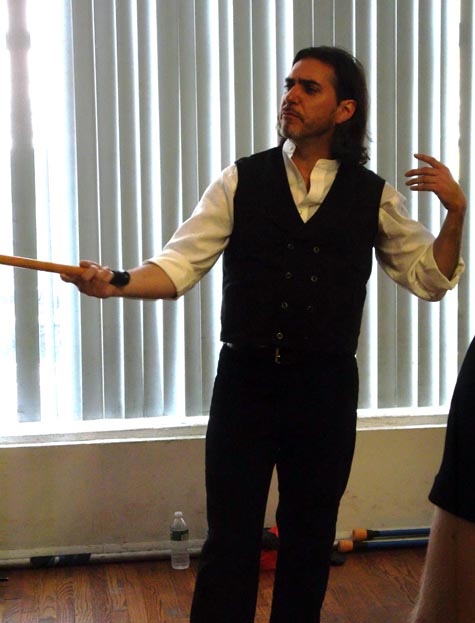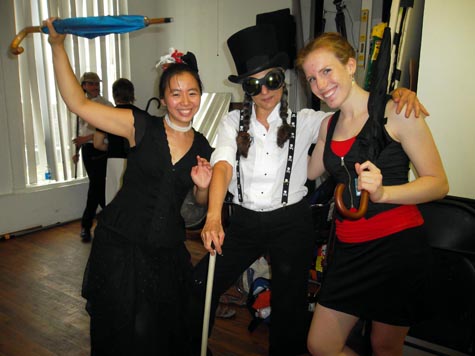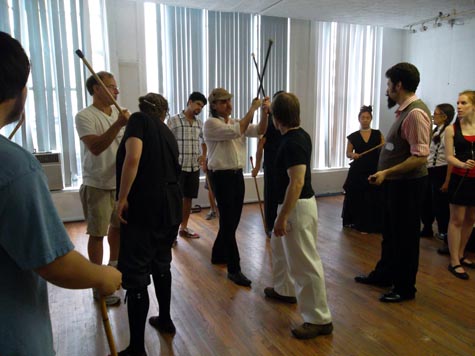“When we hear martial arts today, we hear Bruce Lee and Jackie Chan; we forget that the Western arts have also existed,” Professor Mark P. Donnelly, striking in his black vest and shirtsleeves, began his instructional seminar last Saturday in a New York midtown fighting studio. “It didn’t look anything like kung-fu and karate but it was certainly martial arts.”
What did Western martial arts look like? About 20 students ventured out in the excruciating heat to find out, particularly about bartitsu, an obscure Victorian martial art that’s been getting more pop culture attention lately. Most of the students that day were dressed in street clothes, though some sported vests, long skirts, or bloomers to fit the class theme. Despite two fans running and the AC on full, sweat had already broken out on many brows in the room. Still, we were ready for combat, Victorian-style.
Over the weekend a two-day combat seminar was conducted by Prof. Donnelly, the author of over 20 history books and the producer of history shows for several TV channels including the History Channel, Discovery Channel, National Geographic, PBS, and BBC. He is also one out of a handful of bartitsu experts in the world; he first started studying the fighting form in 1998 and then started teaching it in 2001. For four hours that day (with an additional four for those who came on Sunday), students were taught the basics of blocking, parrying and thrusting with canes and umbrellas in the style that the upper-classes learned over a hundred years ago.
 Bartitsu, the first mixed martial art that combined both Eastern and Western styles, was developed by Edward William Barton-Wright. Born in Bangalore, India, in 1860, Barton-Wright traveled the world and picked up various fighting styles along the way, including scientific pugilism (modern boxing), French savat, wrestling, and jujitsu. When he settled in London, he combined all four forms into one self-defense system, the first of its kind. He named the style after himself, and the Bartitsu Club of London opened in 1902. The school featured instructors from England, Switzerland, and Japan, each teaching their own styles and learning from their comrades.
Bartitsu, the first mixed martial art that combined both Eastern and Western styles, was developed by Edward William Barton-Wright. Born in Bangalore, India, in 1860, Barton-Wright traveled the world and picked up various fighting styles along the way, including scientific pugilism (modern boxing), French savat, wrestling, and jujitsu. When he settled in London, he combined all four forms into one self-defense system, the first of its kind. He named the style after himself, and the Bartitsu Club of London opened in 1902. The school featured instructors from England, Switzerland, and Japan, each teaching their own styles and learning from their comrades.
Prof. Donnelly started off by explaining how bartitsu was based on learning how to fight with whatever one had on-hand. During the Victorian era, every gentleman had a walking cane or pocket watch and women had a parasol, pocket watch or (eek) hat pins, which is why most of bartitsu’s moves employed those accessories. “If I were teaching a modern self-defense form using Barton-Wright’s philosophy,” Prof. Donnelly commented, “I’d probably use a cell phone.”
We learned how to block, parry and strike with canes, to use parasols like bayonets, and how both items can be used to pin down attackers. Best tip of the day: “Aim for the squishy bits.”
Martial arts enthusiasts, historians, and steampunk fans alike all gathered for the class, though many came not because of an interest in Sherlock Holmes or steampunk per se, but for the love of an obscure martial arts form.

Participants Lynn, Annie, and Casey arere fans of steampunk, but were just as interested in embracing other aspects of Victorian culture.
“I introduced my friends to steampunk after going to the Steampunk World’s Fair,” Casey admitted, which was where she first encountered Donnelly’s bartitsu seminar and wanted to learn more.
Her friend Annie, a martial artist trained in stick fighting, fought in period attire and arrived decked out in Victorian mourning. “I even made my little top hat last night with some cardboard and a Sharpie,” she said, pointing to the lacey accessory on her head.
That evening, we cooled off with some drinks and a lecture from Prof. Donnelly at The Way Station in Brooklyn, where he regaled us with anecdotes about street crime in Victorian London, and the variety of contraptions Victorian gentlemen used to defend themselves. Interesting contraptions that were sold to ward off “garrotters” included a pistol that was attached to the lower back and was triggered when the wearer pulled on his jacket lapel, and a spiked collar worn to defend against choke holds.
Barton-Wright’s school proved to be a more viable alternative, but it was not a financially successful one. The school lasted only four years, closing in 1902, though students and teachers afterwards spread across Europe. The legacy of bartitsu was varied: for example, a secret society of bodyguards called the “jujitsu suffragettes” was created by Edith Garrud and protected woman suffragettes during protests, while many documents and books were written by Barton-Wright’s students. It was these papers that Sherlockians and historians sifted through in order to find more information about bartitsu.
Another interesting revelation from Donnelly’s presentation is the factual impossibility of Holmes actually being trained in bartitsu. “The Adventure of the Empty House,” the story where Holmes supposedly fought Prof Moriarty with bartitsu, was set in 1894, and then he was resurrected by Conan Doyle in 1903. Thus, Sherlock would’ve never had a chance to learn bartitsu, for Barton-Wright’s school only existed between 1899 and 1902.
Though the connection between Sherlock and bartitsu has been proven to be an anachronism, growing interest in bartitsu is still connected to the renewed focus on the Victorian sleuth in pop culture, particularly with Guy Ritchie’s movies and Stephen Moffat’s BBC series. Though he admits to being only an avid reader of Sherlock Holmes stories, Prof. Donnelly offered his thoughts on Sherlock’s growing popularity in today’s culture. “I find it interesting that each generation casts Holmes in their own image. We recreate any character that has great longevity; it happens with Shakespeare’s work all the time,” he mused. “It seems like the modern incarnation of Holmes is still an intellectual giant, but also flawed, and you don’t want to mess with him either. He is the quintessential Gentleman Badass.”
More pictures from the event can be found on Tor.com Steampunk. Readers can check out more information about bartitsu on Bartitsu.org. For those in NYC, there is also a monthly Bartitsu Club hosted by NYC Steampunk; future meeting dates will be listed on their website.
When she isn’t off adventuring, Ay-leen the Peacemaker runs Tor.com Steampunk on Facebook and Twitter and the multicultural steampunk blog Beyond Victoriana.










